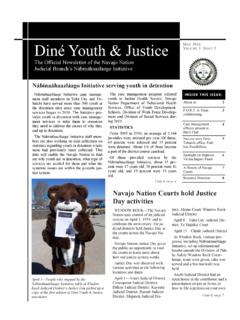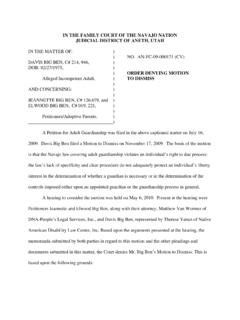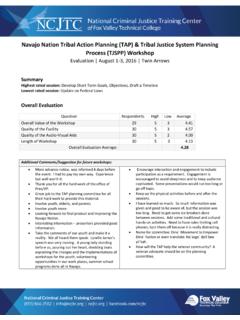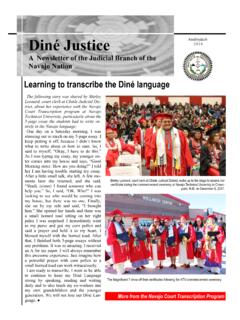Transcription of THE TWENTY-FIFTH ANNIVERSARY OF THE NAVAJO …
1 \\server05\productn\N\NMX\40-1\ unknown Seq: 1 28-OCT-10 10:02. THE TWENTY-FIFTH ANNIVERSARY OF THE NAVAJO . preference IN employment ACT: A QUARTER- CENTURY OF EVOLUTION, INTERPRETATION, AND. APPLICATION OF THE NAVAJO NATION'S. employment preference LAWS . HOWARD L. BROWN *. AND. HONORABLE RAYMOND D. AUSTIN **. I. INTRODUCTION. The NAVAJO Nation is the largest federally recognized Indian Nation in the United States with approximately 225,000 enrolled Approximately 180,000 of those members live within the NAVAJO Nation, in addition to several thousand nonmembers who reside or work The population of the NAVAJO Nation includes a workforce that produces goods and provides services in count- less and diverse fields. Unfortunately, the full potential of the NAVAJO workforce has not yet been reached, as the NAVAJO Nation suffers from epic levels of unem- ployment and persistent, generational poverty.
2 The Official Website of the Twenty-First NAVAJO Nation Council characterizes unemployment and poverty on the NAVAJO Nation as Permanent Issues. 3 The Council's website states: In 1997, fifty-six percent of NAVAJO people lived below the poverty level and the per capita income was reported to be $5,599. Twenty-four percent of personal income made on the NAVAJO Nation is spent on the reservation leaving vast potential for on-reservation economic development. High levels of unemployment persist on the NAVAJO Nation despite our efforts to find ways to attract various types of businesses to locate on the reservation to create jobs and spur economic development. The NAVAJO Nation is challenged daily by the tasks associated with at- tracting businesses to an environment that has little or no infrastructure. On a regular basis, several businesses explore the possibility of locating to The authors presented portions of this article at the 2009 Annual Conference of the NAVAJO Nation Bar Association, Inc.
3 , on June 4, 2009, in Flagstaff, Arizona. * Partner, Shorall McGoldrick Brinkmann, Flagstaff, Arizona. , 1997, Boston College Law School; , 1992, University of Arizona. The author wishes to thank his wife Christy and his children, Seth and Emily, for the time that it took to write this article; co-author Justice Raymond Austin for his extensive knowledge and wisdom regarding the NAVAJO preference in employment Act, the Fundamental Laws of the Din e, and all matters related to NAVAJO jurisprudence; and Tamsen Holm, Esq. and David Barrow, Esq. for providing copies of much of the legislative history cited herein. ** Distinguished Jurist in Residence, Indigenous Peoples Law and Policy Program, James E. Rogers College of Law, University of Arizona, Tucson, Arizona; Retired Associate Justice, NAVAJO Nation Supreme Court, Window Rock, NAVAJO Nation (Arizona).
4 , 2007, University of Arizona; , 1983, University of New Mexico Law School; , 1979, Arizona State University. Justice Austin is Din e from the NAVAJO Nation in northeastern Arizona. The authors thank Maia Campbell, Staff Attorney, Indigenous Peoples Law and Policy Program, James E. Rogers College of Law, University of Arizona, and Ryan D. Dreveskracht, , 2009, James E. Rogers College of Law, University of Arizona, for their editorial assistance. 1. The Official Website of the 21st NAVAJO Nation Council, NAVAJO Nation Profile, http://www. (last visited Apr. 9, 2010). 2. Id. 3. See id. The Twenty-First Council is the current Council, as of the publication of this article. 17. \\server05\productn\N\NMX\40-1\ unknown Seq: 2 28-OCT-10 10:02. 18 NEW MEXICO LAW REVIEW [Vol. 40. the NAVAJO Nation before realizing the obstacles of inadequately paved roads and the lack of electricity, water, and telecommunication services, not to mention limited police and fire This statement reflects the NAVAJO Nation Council's goal of reducing unemploy- ment and poverty through legislative efforts to attract businesses to the NAVAJO Nation, despite the challenges arising from a lack of infrastructure.]
5 The NAVAJO Nation's executive branch has a similar goal and perspective regarding the Na- tion's infrastructure. The website of the NAVAJO Nation Division of Economic De- velopment, a department within the executive branch, states: The main purpose of this Division is to create an environment that is con- ducive to promoting and developing businesses .. thereby creating jobs and business opportunities.. Our Mission is based on the following objectives: To create employment for the NAVAJO people and business opportu- nities by promoting commercial, industrial, tourism, and other pri- vate sector business development. To enhance economic development on the NAVAJO Nation and to cre- ate a positive business The site also notes, The NAVAJO Nation has a mix of urban growth centers with infrastructure in place and vast acreage of undeveloped land.
6 In this vast acreage, the lack of infrastructure is a major challenge for the development of the NAVAJO economy. 6. Although the foregoing statements of the NAVAJO Nation Council and the Divi- sion of Economic Development highlight the NAVAJO Nation government's current approach to solving the unemployment problem through economic development and by attracting employers to the NAVAJO Nation, for years the government has taken an employee-rights approach to addressing the unemployment problem. In 1985, the NAVAJO Nation enacted the NAVAJO preference in employment Act (Act or NPEA),7 which created wide-sweeping rights for NAVAJO workers. This was done for the laudable purposes of creating employment opportunities for Navajos, de- creasing the NAVAJO Nation's dependence on off-reservation sources of employ- ment, and bolstering the economic self-sufficiency of NAVAJO Since 1985, the Act has evolved through legislative amendments and judicial interpretation and its impact on employers and employees has been felt through 4.
7 Id. 5. NAVAJO Nation Division of Economic Development, Our Organization and Its Mission, http://www. (last visited Apr. 9, 2010). 6. NAVAJO Nation Division of Economic Development, All Roads Lead to NAVAJO , http://www. (last visited Apr. 9, 2010). 7. NAVAJO NATION CODE tit. 15, 601 619 (2005). The NAVAJO Nation Code is hereinafter cited as ____ ____, in accordance with citation instructions set forth in the Code itself. All references to the Code are to the 2005 edition, unless otherwise stated in the citation. NAVAJO Nation court opinions are cited in accordance with the NAVAJO Nation Supreme Court's Order Establishing a Uniform Citation System for Opin- ions, as set forth in In re a Universal Citation System for the Decisions of the Courts of the NAVAJO Nation, No. SC-SP-01-00, slip op. at 1 2 (Nav. Sup. Ct. January 23, 2004). 8. See 15 602.
8 \\server05\productn\N\NMX\40-1\ unknown Seq: 3 28-OCT-10 10:02. Winter 2010] THE NAVAJO preference IN employment ACT 19. countless administrative Unfortunately, despite (or perhaps because of). years of evolution, the Act has been the source of costly and time-consuming em- ployment-related litigation within the courts of the NAVAJO Nation10 and the federal judicial The litigation often results from employers' lack of knowledge of the Act's requirements, employers' refusal to comply with the Act, and employers contesting the NAVAJO Nation's power to regulate their employment activities, and employees' unrealistic expectations about the Act's protections. There is no shortage of willing and able employees on the NAVAJO Nation. Un- fortunately, there is also no shortage of time-consuming and expensive employ- ment-related This type of litigation, regardless of whether the case-by- case results tend to favor employers or employees, can only serve as a deterrent for businesses that might otherwise be eager to avail themselves of the many opportu- nities to conduct operations on the NAVAJO Nation.
9 Potential employers may be reluctant to locate their operations on the NAVAJO Nation because of the volume and cost of litigation arising from the Act, the fear (whether justified or not) that the Act is interpreted and applied too severely and in a manner that is hostile to employers' interests, and the resulting uncertainties about the employer/employee relationship on the NAVAJO Nation. In 2000, the NAVAJO Nation Supreme Court recognized this reality when it wrote in one of its published opinions, We are mindful of the economic impact of our interpretive rulings of the NPEA. Interpreted too strictly, the NPEA might dis- courage business owners and employers from locating their operations on the Nav- ajo Nation. 13 In this brief, but profound statement, the highest court of the NAVAJO Nation signaled the need for the government to strike a reasonable, pragmatic balance between (1) honoring and safeguarding employee rights under the Act and (2) establishing a system of laws that creates a positive business environment that is not overburdened with litigation and which provides employers with the cer- tainty that they need to justify their business risks.
10 When this balance is reached, employers will be more apt to locate their operations on the NAVAJO Nation, pros- per, and thereby generate employment opportunities for NAVAJO 9. As will be discussed in Parts III and IV of this article, the codification, interpretation, and applica- tion of NAVAJO preference in employment dates back many years (including the creation in 1972 of the Office of NAVAJO Labor Relations, see Record of the NAVAJO Tribal Council 70 (Jan. 19, 1972)), and is continually undergoing changes through agency application and court interpretation. 10. In 2007, the NAVAJO Nation Supreme Court published twenty opinions. Of those, approximately one-third arose from the NPEA. See generally NAVAJO Nation Supreme Court Opinions, http://www. (last visited Apr. 12, 2010). 11. See, , Dawavendewa v. Salt River Project Agric. Improvement & Power Dist.











